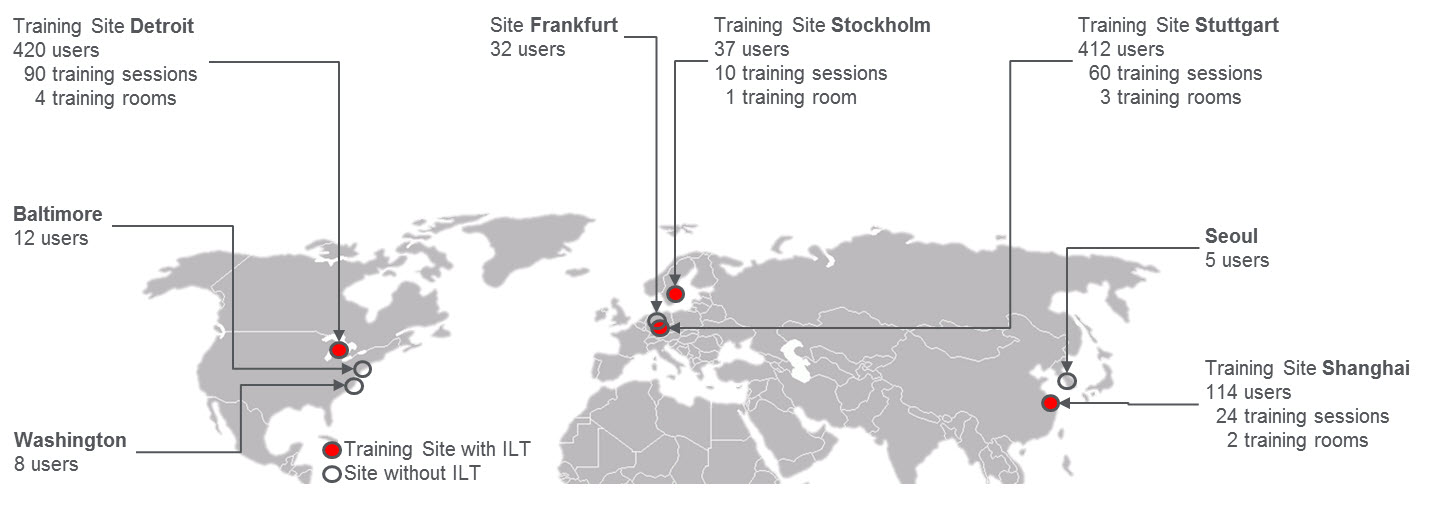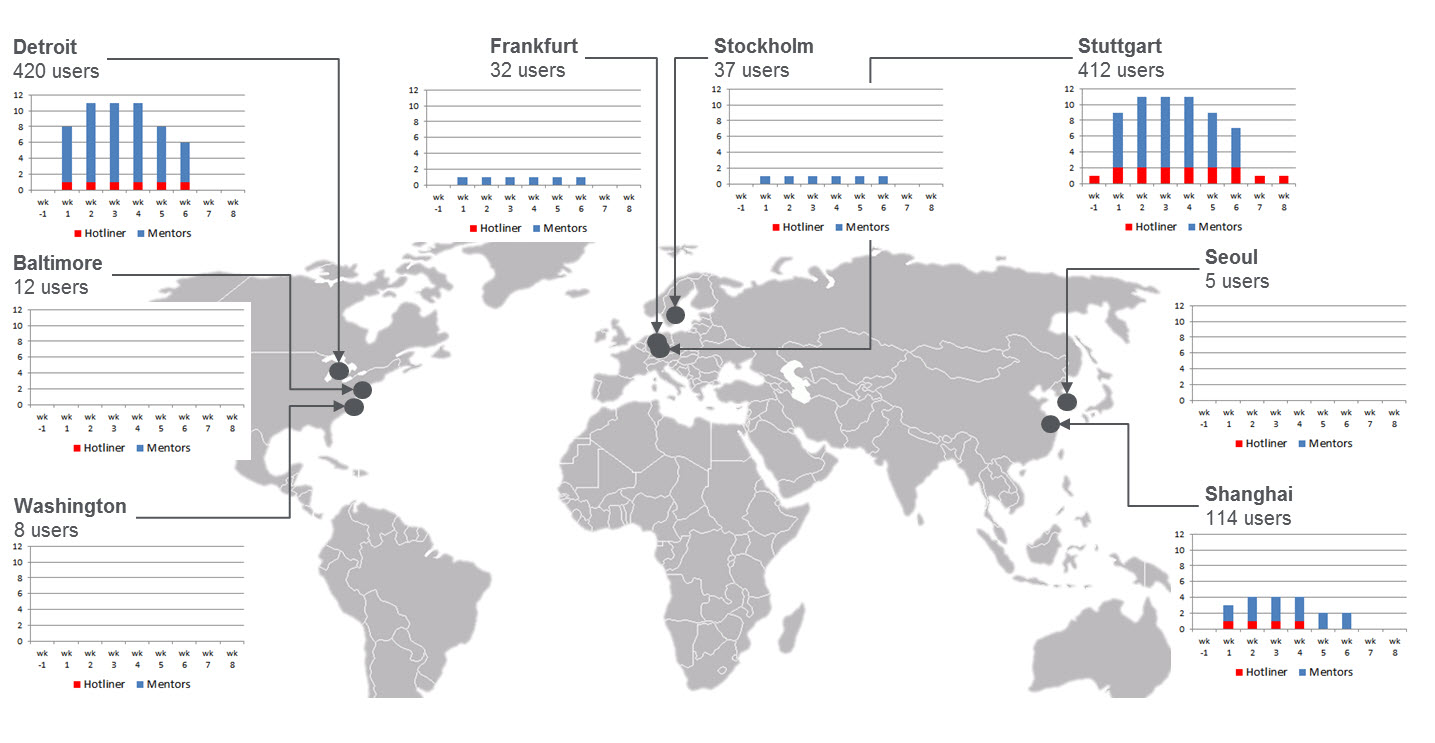Community Tip - Visit the PTCooler (the community lounge) to get to know your fellow community members and check out some of Dale's Friday Humor posts! X
- Community
- Customer Success
- PTC University Training
- Learning & Adoption Strategy – Where to Inform, Tr...
- Subscribe to RSS Feed
- Mark Topic as New
- Mark Topic as Read
- Float this Topic for Current User
- Bookmark
- Subscribe
- Mute
- Printer Friendly Page
Learning & Adoption Strategy – Where to Inform, Train and Support Your Teams?
- Mark as New
- Bookmark
- Subscribe
- Mute
- Subscribe to RSS Feed
- Permalink
- Notify Moderator
Learning & Adoption Strategy – Where to Inform, Train and Support Your Teams?
In my previous articles, we talked about the value of having an early Learning & Adoption Strategy in place and the question of who shall be trained. In this part of my little Learning & Adoption series, we will take a closer look at the users’ sites as an influencing factor of your strategy: WHERE does our staff need to informed, trained and supported?
While your Learning & Adoption Strategy is being defined, you already need to look into the required resources. This might surprise you, but one of the most critical resources we are dealing with in training projects are the training rooms. In previous projects, we have often seen that training rooms are not available where needed. Or, if available, the rooms are already booked for months in advance. Not to mention the technical equipment which is sometimes insufficient. Often, corporate training rooms use discharged computers from the offices – which are most likely not sufficient to support hands-on trainings or workshops for new implementations.
Certainly, training rooms are only one part of the “where” to be considered in a Learning & Adoption Strategy. However, it’s essential to calculate the required rooms, check availability and reserve them as soon as possible. If the local ability to execute training is not given there will be a need to change other Learning & Adoption decisions, such as the didactical methods. Instructor-led trainings (ILT) might need to be changed to other methods, such as Web-based training (WBT). I will discuss the HOW decisions in a separate article, and you will see that the WHERE and the HOW decisions do heavily impact each other.
For receiving a simple and useful overview on the overall local needs it has been shown as feasible to split-up into three focus areas on the WHERE:
- Information Sites
In general, all sites with users shall be declared as information sites. All users being affected by a system or process change shall be informed before the change appears or the training invitation is published. For proper information planning a so called “Organization Readiness Map” should be created based on a change impact analysis to see the need for information and motivation per site. The organization readiness analysis should include the nature of change and change impact containing topics of- Strategy: Vision, Model, Business Strategy
- Technology: Methods, Procedures
- Organization: Structures, Processes
- Culture: Leadership, Communication
Based on the expected change impact and the organizational structure of a site the category of an information site can be defined, for example
- Information sites with major impact
"Major" information sites need a well-planned and prepared campaign, appropriate communication artifacts, a dedicated and well-trained person called “Project Ambassador” and, in addition, there should be multiple communication loops to measure the success of the information and motivation:
define adoption goals --> plan communication --> execute --> measure --> define adoption… - Information sites with medium impact
"Medium" information sites need the same communication as major sites, but may have a reduced effort of the Project Ambassador or reduced communication loops - Information sites with low impact
"Minor" information sites still need appropriate communication aligned to the users’ roles and the manager´s information needs. The information and motivation campaign may be set-up mainly as a one-way-information and multiple loops are normally not necessary.
The “Adoption Site Map” shows a summary based on an organization readiness analysis:

- Training Sites
At sites where enough users are located to fill-up classrooms of scheduled instructor-led trainings, classrooms shall be planned early. The influencing factors are
- How many users per training path are located in a site?
- How many classrooms of different training classes will be offered at a site?
- Are instructors available to deliver the variety of courses at a site?
- How many ILT training days shall be delivered at a site?
- What is the effort to prepare a site as a training site?
As a rule-of-thumb for the calculation of a training site the following formula can be used: hardware and network costs + preparation costs < user´s travelling costs to other training sites. Of course other influence factors shall be considered, such as the needed flexibility of users being trained on-site, future needs of on-site trainings after the project or needs from other projects.
For identifying the training sites there are some typical questions to ask:
- How much different training is needed at this site? Will the classrooms for ILT be filled?
- Is it a “must” having ILTs at this site? Can users at this site receive their training by other didactical methods such as WBTs or virtual training classes (Virtual Classes – VC)?
- Can users travel to other sites?
- Is a training room available, fully equipped and worth being called a “training room”?
- If available: can a room be prepared as training room?
Practice has shown that a “Training Site Map” is easier to understand than tables listing this type of information:

Tip: Even if a contact person at a site confirms having a training room in place, ask for a checklist to be filled out in order to classify the training room’s equipment and evaluate in regard to the project needs. For example, ask for the number of computers, the computers´ age, the network performance, the number of chairs and tables, windows, lighting, power supply, restrooms near to the training room or beverages supply. The term “training room” is very broad, depending on whom you ask!
- User-Support Sites
The early definition of sites where on-site mentors shall support the end-users during their first weeks of the new system’s usage is essential for calculating the training needs of the mentor user group. This user group is one of the most important factors influencing the end-users’ motivation after the go-live. Supporting the end-users means guaranteeing a successful and valuable implementation. Thus, the mentors need to be informed, motivated and trained as a separated group early and extensively.
In addition to a local mentor, a project-specific central support hotline may be planned and established. The central support hotline’s tasks are:
- Coordinating the local mentors
- Collecting user questions and system issues, tracking and analyzing incidents
- Suggesting additional training or information based on the system implementation status or user requests
- Creating and updating central FAQ information
- Supporting the local mentors as their dedicated 2nd-level-support
- Creating workarounds and tips & tricks and informing the local mentors
- Supporting end-users without a local mentor at their site
- Reporting implementation issues from the field to project management, process management and technical teams
- Contact point for the general IT-Support
Again, a picture tells more than tables. The User-Support Map shows the number of local mentors (blue bar) needed per site/per week and the location and duration of a central support hotline (red bar):

Each of these 3 activities of training site definition, information site definition and user-support site definition needs its own analysis, estimations and decisions to be considered in the Learning & Adoption project. Especially the training site map needs higher attention, even if the effort for creating the map is less. But the impact on costs for training delivery and the impact on the training didactics are often underestimated. At the time of defining a Learning & Adoption Strategy the first draft of a training plan should be created showing how much training rooms in a certain time frame are needed at a site.
Here are some tips to consider the WHERE in a Learning & Adoption Strategy:
- For getting an impression of the local training culture ask for experiences from previous implementation projects. Focus on questions about the didactical mix between ILT/VC/WBT and consider the feedback in the new project.
- Check with corporate or local Human Resources (HR) departments if there is a team or budget for supporting change management. Involve HR as soon as possible.
- Contact the local unions and worker’s council as soon as possible. Check-out their influence and opinion in employee training.
- Check if there is already an existing key-user community in place. These key-users may be the best persons to leverage as mentors.
The estimates made in a Learning & Adoption Strategy may be accurate by +-20% only. But having some inaccurate estimates and a very early follow-on action like booked training rooms is much better than having perfect effort calculations … but too late.
The next step following a Learning & Adoption Strategy is the Learning & Adoption Needs Analysis, where the details will be worked-out. These details and decisions are the Role-based Training Plan, the Communication Plan and the User Support Plan; all based on the major decisions decided in the strategic planning, such as the already booked training rooms or suggested number of mentors.
In Part 4 of this Learning & Adoption blog series, we will talk about defining the milestones of training and end-user information projects (WHEN).


